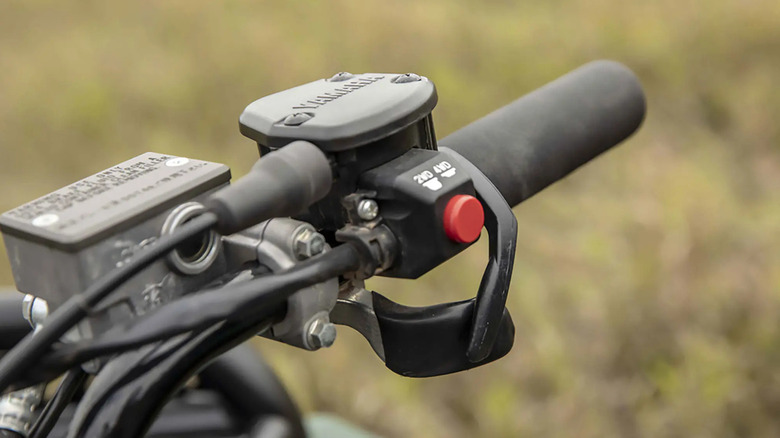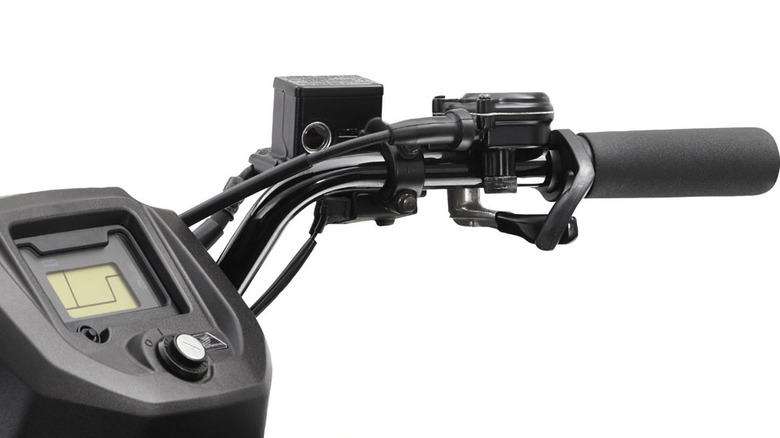Why Do ATVs Have A Thumb Throttle?
You've probably met the thumb throttle if you've ever hopped on an ATV and reached for the gas. It's that little lever tucked under the right side of your handlebar, and it's rather simple to use. You just push it with your thumb and off you go. The mechanism resembles a controller's trigger and differs from the other option, twist throttles, where you roll the whole grip to accelerate. In contrast to twist throttles, thumb throttles allow you to keep your wrist in a neutral position to maintain a firmer grip on the handlebars.
Meanwhile, twist throttles are more common on motorbikes and e-bikes, and can feel more natural if you're used to that style. They let you wrap your whole hand around the grip and give it a smooth twist to ramp up speed. But while that might sound more intuitive, it can be a mixed bag on an ATV. Let's dive in to see why.
Why thumb throttles just make more sense on ATVs
Thumb throttles have always been there with ATVs. The very first factory-built ATV, Honda's original US90, featured a thumb throttle back in the 1970s. Even early youth-focused models like the 1984 Yamaha Tri-Zinger YT60 opted for a thumb-style lever — something highlighted in our look at Yamaha's coolest ATV designs.
Still, as a blog post by ATV Connection highlights, the idea was actually borrowed from snowmobiles. Snowmobiles operate in freezing temperatures where twist throttles risk freezing up and locking the throttle open. While that made sense in cold environments, ATVs aren't always used in such conditions, so the reasoning went deeper. Engineers also discovered that ATV riders sit in a different posture than motorcyclists, and the extra leverage needed to steer a heavier machine made the thumb throttle a smarter fit.
What really solidified its place, though, is safety. Twist throttles, though fun on the right bike, have a bad habit of accelerating unintentionally when you hit a bump. Imagine flying over a rut and your hand rolls the throttle by mistake. Thumb throttles remove that risk. Moreover, since power only kicks in when you press down intentionally, you're far less likely to experience runaway acceleration. This design lets riders focus more on handling and less on worrying about keeping their wrists steady over unpredictable terrain. Some models — like certain years of the Yamaha Raptor — have even integrated throttle limiters and ergonomic tweaks to suit a wide range of riders.
Thumb throttle not your thing? You've got options
That's not to say thumb throttles are perfect for everyone. Extended riding sessions can lead to thumb fatigue, especially for folks dealing with hand strength issues. Some ATV enthusiasts who also ride motorcycles may find switching between thumb and twist jarring too. Luckily, there are plenty of accessories you can use to modify your ATV, and there are options for throttle mods — aftermarket conversion kits. Products like the Handy Throttle Thumb Throttle Converter add a twisting mechanism that pushes against the stock throttle.
Swapping out the entire assembly is another option, though you have to make sure your ATV's system allows for it. But not all modern machines, especially those with electronic throttle controls, have easily modifiable throttles. If your ATV does support a swap, it's a somewhat straightforward job. You'll remove the thumb throttle assembly and cable, fit in the twist throttle components, test it out in a safe environment, and you're good to go. A proper installation is crucial, as a bad throttle setup can mean big trouble on the trail.


